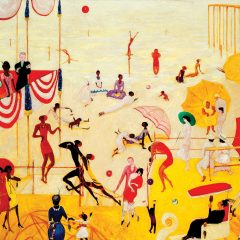If you’re looking for a snapshot of some of the black artists creating and selling comix, aka independent comics, check out Black Comix: African American Independent Comics Art and Culture.
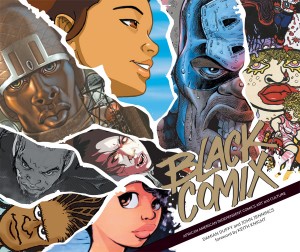
The book is an alphabetical catalog illustrated with comix excerpts and cartoon samples. I have to imagine the people included are just the tip of the iceberg. They range from a mix of pros with heavy establishment track records, like Larry Stroman and Keith Knight (who wrote the book’s foreword) to some with mainly self-publishing on their resumes–younger artists like Leilani Hickerson or Ken Patterson, but the variety of work is delightful and made me want to read further.
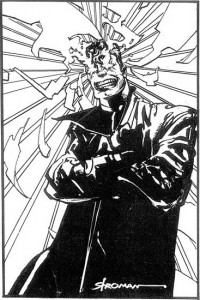
The book is by comic artist Damian Duffy and University of Illinois Art and Design Professor John Jennings. They are the duo who curated the 2008 exhibition Out of Squence: Underrepresented Voices in American Comics and the 2007 exhibit Other Heroes: African-American comics creators, characters, and archetypes.
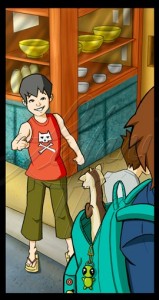
This book places a number of relatively unsung artists into the record–well, unsung in some circles, but that is the whole point here–widening the circle, and archiving the network.
A number of the artists included are from Philadelphia, including Jamar Nicholas (he’s the guy who works at Arcadia U’s art gallery) and Yumy Odom. The two of them are moving forces behind the annual East Coast Black Age of Comics Convention (ECBACC) which began in Philadelphia in 2002. “It started in a hallway at Temple [University],” Jamar said. Now it attracts about 500 to 600 participants.
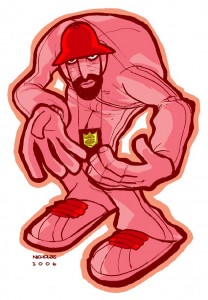
Nicholas is the author of the webcomic Detective Boogaloo and created a new, illustrated adaptation of Geoffrey Canada’s Fist Stick Knife Gun: A Personal History of Violence.
I have one big complaint and a few petty complaints about the book. First the big one–the essays gloss too lightly over their subjects. And now the picky complaints–the glossy pages obscure the images with reflections, and the typos and proofing mistakes are embarrassing. Shepherd Hendrix’s first name is is misspelled. Is Ken Patterson, born in Jackson, Mississippi, really living in Jackson, Massachusetts? Was ECBACC really at Truman University in North Philadelphia?
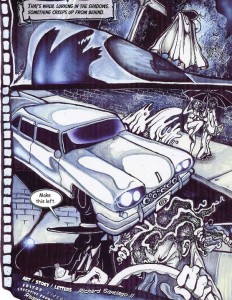
On the other hand, the book makes no pretenses of being comprehensive, and the imagery is juicy and as varied as there are contributors to the book. So are the genres varied–from comic strips to full-blown sagas. There’s something here for Edge City lovers, and something here for X-Men lovers. While some superheroes look a lot like the usual suspects, others are no such thing. The artists reference aesthetics from old comic strips, ’50s superheroes, manga, graffiti art, Mexican muralists, Matisse, fashion drawings, Mad Magazine, Vargas cartoons, R. Crumb, Erte, Toulouse Lautrec–any visual imagery that’s out there is fodder for reinvention.
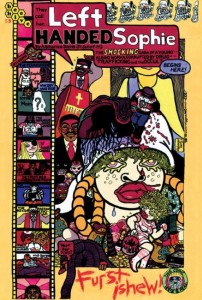
I love Stroman’s high-contrast graphics which pop from the page. Richard Santiago II’s Broken Glass drawings are like melted glass or pulled taffy. New Jersey artist Leilani Hickerson’s My Hafu gets a load of teen culture but it sure ain’t Archie (she has a degree from UArts). Phonzie Davis’ overloaded, yummy Left Handed Sophie drawings remind me of old carnival posters.
While I was reading a book featuring only African American artists, I began to wonder about the premise. Davis is a member of Meathaus, which is a cartoon collective with nothing to do with race.
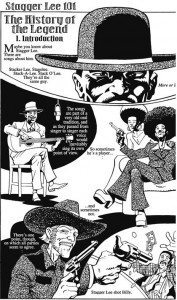
In part the book is an answer to the old story that the comic book industry wasn’t showing black faces, so there were a couple of generations that began looking for themselves and found they were invisible. Thanks to those artists, to some degree black faces are no longer invisible in comix land. For starters, this book exists! And there are a number of black comix conventions around the US.
Superman and Batman may still dominate in the establishment corporate superhero categories. But in self-published comix land (thanks to the magic of internet publishing), darker faces are finding their audience. This book is like a guide to the galaxy of these artists, a first step that can take you onto the internet and then link by link navigate to new dimensions. The book has great stuff to look at, stuff to love, stuff to hate, and just lots of interesting minds and hands at work. It’s a starting point and it’s an archive, a way to say, We are here.
Black Comix
African American Independent Comics, Art and Culture
Damian Duffy & John Jennings
Page Count: 176 pages
Size: 11 x 9 inches
Publication Date: July 2010
Price: $45
ISBN: 978-0-9841906-5-2



